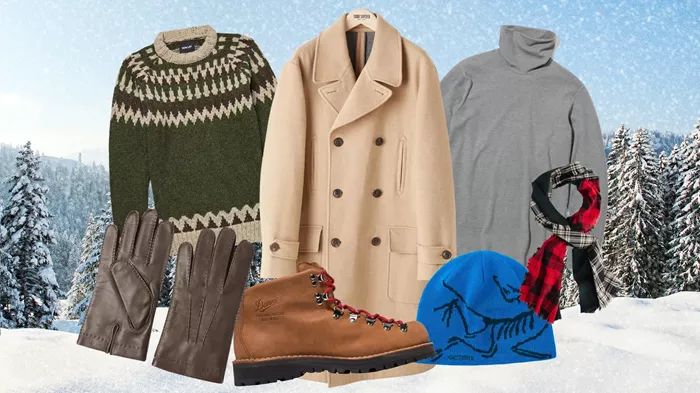When the temperatures drop and the chilly winds start to blow, dressing appropriately becomes not just a matter of style, but of comfort and health. Whether you’re heading to work, hitting the slopes, or simply going for a stroll in the winter wonderland, understanding how to layer and what materials to choose can make a significant difference in how warm and cozy you feel. This guide will walk you through the essentials of men’s cold weather clothing, from base layers to outerwear, ensuring you stay stylishly snug in even the harshest conditions.
Base Layers: Building Your Foundation
The key to staying warm in cold weather starts with your base layers. These form the foundation of your outfit and are designed to wick moisture away from your skin while providing insulation. Here’s what you need to know about choosing and wearing base layers:
1. Materials Matter: Opt for materials like merino wool or synthetic fabrics such as polyester blends. These materials are excellent at moisture management and retain warmth even when wet.
2. Fit: Base layers should fit snugly against your skin without being restrictive. This close fit helps trap warm air next to your body.
3. Layering System: Consider using a layered approach with a lightweight base layer followed by heavier options as needed. This allows you to adjust your insulation level based on the weather conditions and your activity level.
Mid Layers: Adding Insulation
Mid layers provide additional insulation and help regulate your body temperature. They should be breathable and moisture-wicking to keep you comfortable. Here are some common mid-layer options:
1. Fleece Jackets: Fleece is lightweight, breathable, and quick-drying, making it an ideal mid layer for cold weather.
2. Down Jackets: Down jackets offer excellent warmth-to-weight ratio and packability. They are perfect for layering under a shell in very cold conditions.
3. Synthetic Insulated Jackets: These jackets are water-resistant and maintain warmth even when damp. They are a good alternative to down for wet conditions.
Outerwear: Protecting Against the Elements
Outerwear serves as your first line of defense against wind, rain, and snow. Choosing the right outerwear depends on your specific needs and the conditions you expect to encounter:
1. Waterproof vs. Water-Resistant: Waterproof jackets are essential in wet and snowy conditions, while water-resistant options are sufficient for light rain and snow.
2. Shell Jackets: These are typically windproof and waterproof, providing protection without adding much insulation. They are designed to be worn over mid layers.
3. Parkas and Overcoats: For extreme cold, opt for parkas or overcoats that cover your thighs and provide maximum insulation. Look for features like fur-lined hoods and adjustable cuffs for added warmth.
See also:Guide For Men At 40: Dressing With Style And Confidence
Accessories: Completing Your Cold Weather Look
Accessories play a crucial role in keeping you warm and comfortable in cold weather. Consider these essential items:
1. Hats: A hat that covers your ears is essential for preventing heat loss. Choose wool or fleece for insulation.
2. Gloves or Mittens: Insulated gloves or mittens are crucial for keeping your hands warm and protected from frostbite.
3. Scarves: A scarf or neck gaiter can add extra warmth and protection from the wind. Look for materials like wool or fleece.
Footwear: Keeping Your Feet Warm and Dry
Cold feet can quickly ruin your outdoor adventures. Here’s what to look for in cold weather footwear:
1. Insulation: Look for boots with insulation to keep your feet warm. Thinsulate and PrimaLoft are popular insulation materials.
2. Waterproofing: Ensure your boots are waterproof to keep your feet dry in snow and slushy conditions.
3. Traction: Opt for boots with a good tread pattern for traction on snow and ice.
Layering Techniques: How to Layer Effectively
Layering is the key to staying comfortable in fluctuating temperatures. Follow these tips for effective layering:
1. Base Layer: Start with a moisture-wicking base layer to keep sweat away from your skin.
2. Mid Layer: Add one or more insulating layers, such as fleece or down, for warmth.
3. Outer Layer: Finish with a waterproof or water-resistant shell to protect against wind and precipitation.
Style Tips: Looking Sharp in Cold Weather
Cold weather doesn’t mean sacrificing style. Here are some tips to keep you looking sharp:
1. Choose Classic Colors: Stick to neutral colors like black, navy, gray, and olive for versatility.
2. Tailored Fit: Opt for outerwear that is tailored to your body shape for a sleek and polished look.
3. Layer Textures: Mix and match different textures, such as wool, fleece, and leather, to add visual interest to your outfit.
Conclusion
With the right clothing and layering techniques, you can stay warm and stylish in even the coldest weather. Remember to choose materials that provide insulation and moisture management, layer effectively, and invest in quality outerwear and accessories. Whether you’re braving the urban jungle or exploring the great outdoors, this guide ensures you’ll be well-prepared for whatever winter throws your way.
Related topics:
- A Comprehensive Guide To Women’s Plus Size Dress Suits
- Defining Plus Size Women’s Clothing: Insights And Factors
- Guide To Best Online Sites For Women’s Plus Size Clothing

